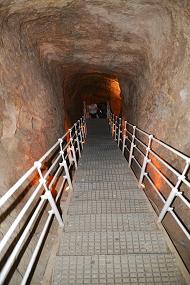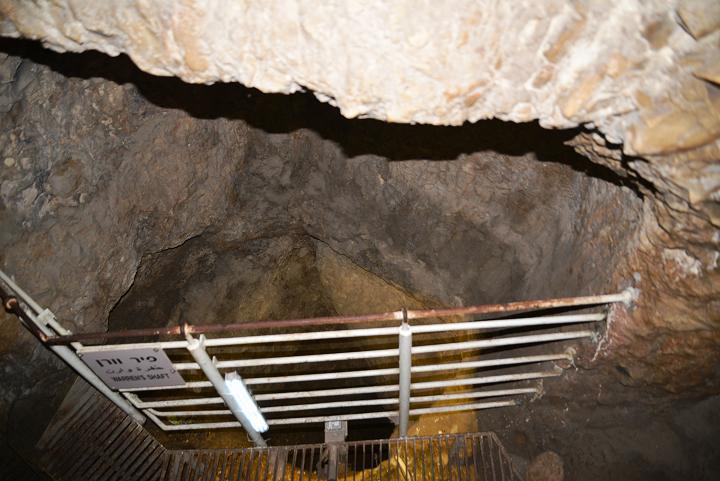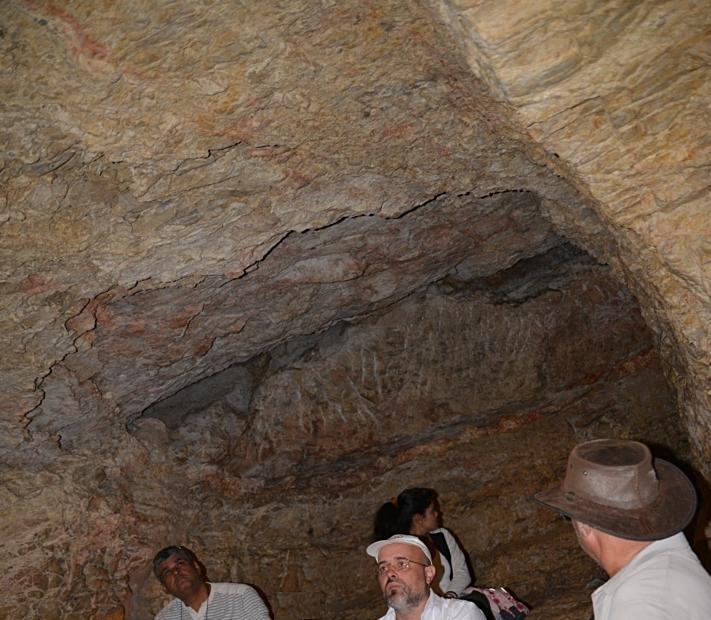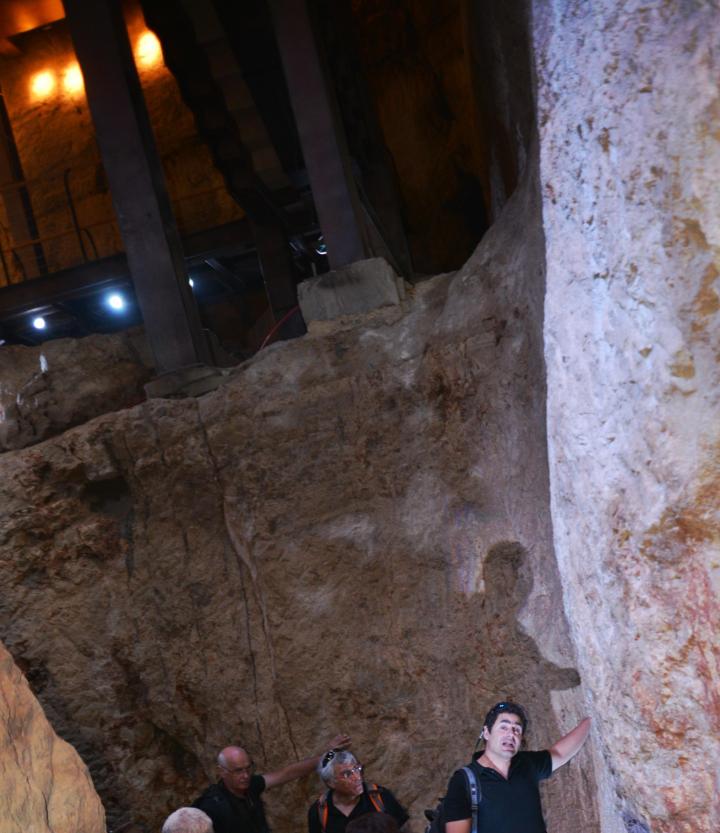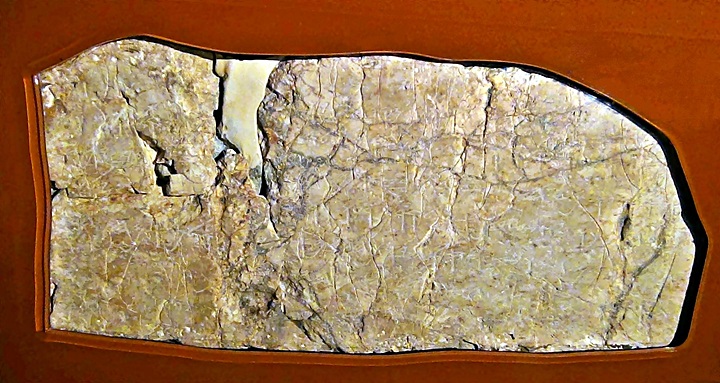The main source of water in Jerusalem during the Canaanite and Israelite Kingdom periods. Around the spring are tunnels, fortifications and pools that were constructed to better utilize and protect the water supply.
* Site of the Month Nov 2013 *
Home > Sites > Jerusalem > City of David > Gihon Spring
Contents:
Overview
Location
History
Plan
Photos
* Kidron
* Entrance
* Secret tunnel
* Warren Shaft
* Spring House
* Gihon spring
* Hezekiah Tunnel
* Canaanite tunnel
* Findings
Etymology
Links
Overview:
The Gihon Spring is an ancient water source located in the City of David, an archaeological site in Jerusalem, Israel. The spring is believed to be one of the oldest and most reliable water sources in Jerusalem, and it has played an important role in the city’s history for thousands of years. A number of complex water supply systems were constructed here during the Canaanite and Israelite periods, built in order to improve the access to the spring while preventing the enemy to reach the source.
The Gihon Spring is mentioned in the Bible as the site where King David was anointed as the king of Israel. According to the biblical account, David’s son Solomon was also anointed there, and the site was later fortified by King Hezekiah in the late 8th century BC. (2 Chron. 32 30): “Hezekiah also stopped the upper watercourse of Gihon, and brought it straight down to the west side of the city of David”.
Today, the Gihon Spring is still a functioning water source, and it is an important archaeological site in Jerusalem. Excavations in the area have uncovered a number of important finds, including a tunnel that was built to supply water to the city during the First Temple period.
Visitors to the Gihon Spring can explore the area as part of a guided tour of the City of David. The tour includes a visit to Hezekiah’s Tunnel, which is the water tunnel that was built to supply water to the city during the First Temple period. It is a fascinating way to learn about the history and archaeology of Jerusalem and to appreciate the importance of water in the ancient world.
Location:
An aerial view of the area of the “City of David”, with an indication of the major points of interest, is shown here. The Gihon spring is located underground on the foothills of the “City of David”.

History:
See the city of David
Plan:
The area around the Gihon spring went during the history of the past 38 centuries through a series of fortifications, construction of installations and access passageways and tunnel diversions. The complex includes a series of tunnels and channels, marked by the archaeologists by letters I through VIII, walls , vaults, staircases, shafts and more. These are located in different levels, constructed in different periods, which further complicates the understanding of the water complex.
To assist in understanding this complicated underground system, the following illustration shows the major points of interest. The entry to the Gihon spring was from inside the city walls, by a secret tunnel, which led to a pair of caves near the spring. The Canaanites (18th-10th century B.C.) protected the spring by a tower, accessed from the caves through a fortified corridor. At the bottom of the tower was a large underground built pool, which was filled by spring water via Tunnel III. The Canaanites also watered their fields and the King’s garden in the valley of Kidron, by an underground channel II. The Israelites (10th – 6th century B.C.) cut new tunnels (IV, VI, VIII), diverting the waters into the area within the city walls, then south to the Shiloah pool.
Confused? No wonder… Perhaps the photos and information on the remainder of the page will help.
Photos:
(a) Kidron Valley:
This picture shows a view of the valley of Kidron, looking towards the south. On the east (left) side are the houses of the Arab village of Silwan, which is built on the southern ridge of the mountain of Olives.
The Gihon spring flows at the bottom of the hill. Its outlet is seen on the bottom of the photo, on the west (right) side of the valley. Above the outlet, high above the valley, are the remains of the Biblical city of David. It was built around the spring, since it was the only source of water supply in the area.
Click on the photos to view in higher resolution…
(b) Entrance to water system:
A spiral ladder leads down to entrance to the water system.
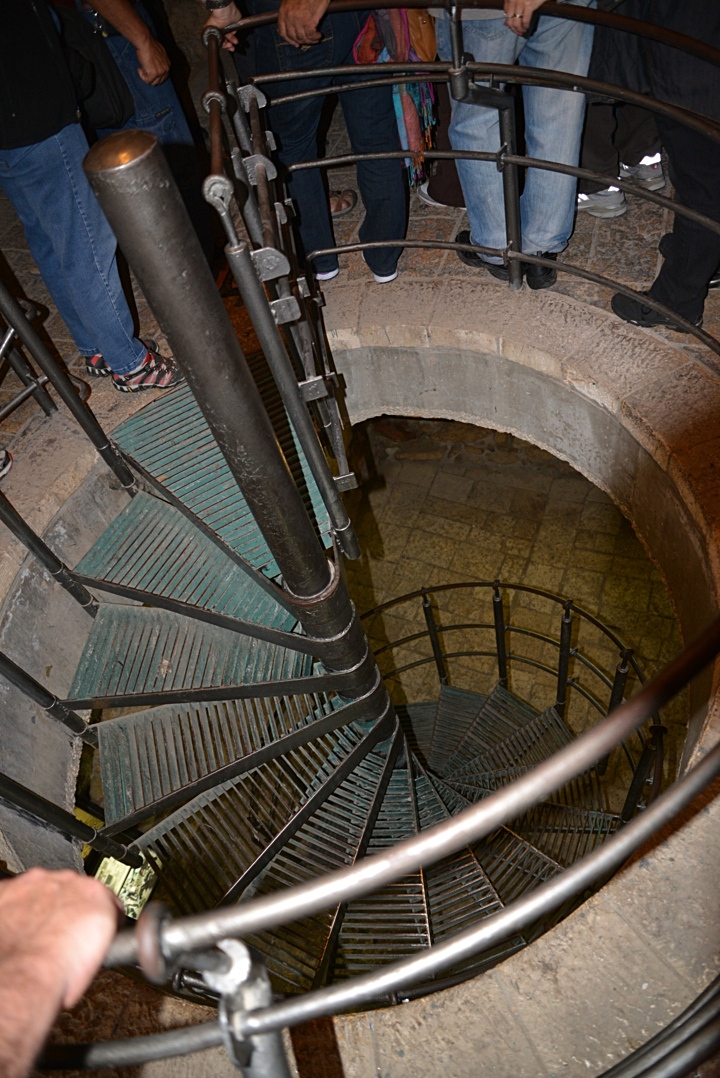
On a lower level is an arched hall, where pictures of findings of the excavations are on display.

(c) Secret Tunnel
The tunnel was used by the residents of the Canaanite city to descend from the city level (altitude of 667m) to the level of the spring (635m), in order to fetch the water.
The location of the tunnel is illustrated as a red square along the yellow colored tunnel.
The photo below shows the first section of the tunnel, descending at a steep angle. Under the modern metal staircase are remains of an ancient built staircase, probably built of wood.

Sections of the tunnel are straight:
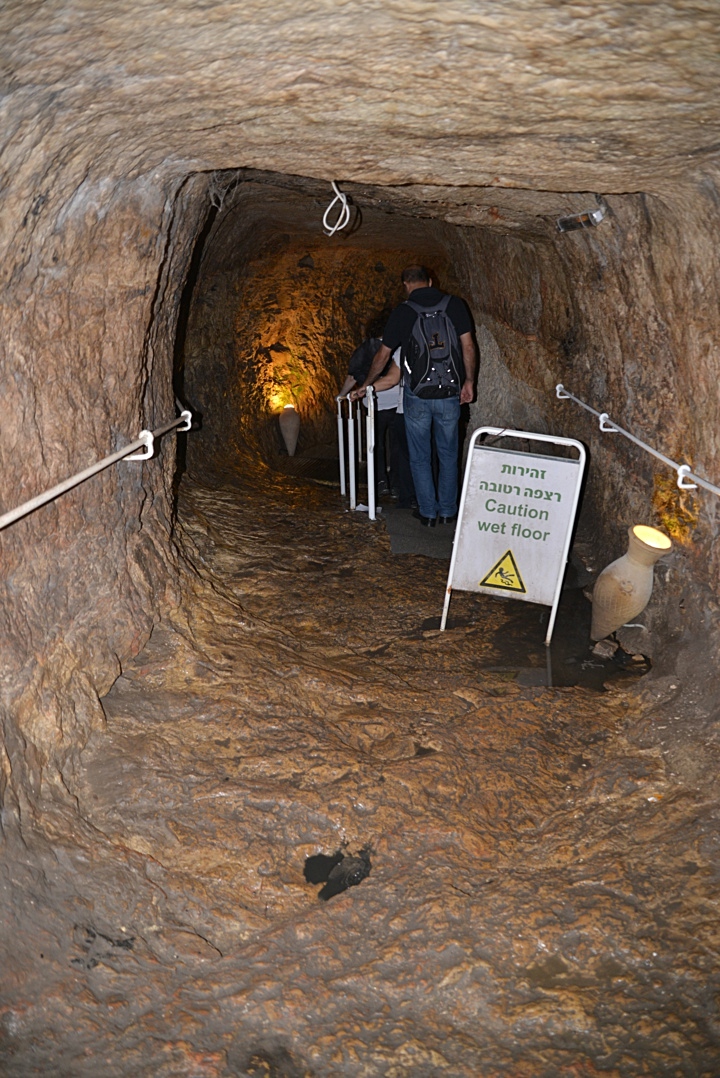
Along the walls of the tunnel are niches, where the oil lamps or candles were placed in order to provide light. You may notice two such niches in the center of the following photo.

(d) Warren shaft
At a height of 647.2, or 20m lower than the entrance, is a vertical shaft that goes down to the level of the spring. It was discovered in 1867 by Charles Warren and is named after the explorer. The shaft was then cleaned by the British Officer M. Parker (1909-1911) in his attempt to find the “treasures” of the temple. The shaft had to be cleared again in Igal Shiloh’s excavations (1978-1985).
The location of the shaft is shown on the illustration as a red square, at the end of the secret tunnel.
It was initially assumed that the shaft was used by the ancients to fetch the waters from the spring level, which is 12m below the tunnel. This theory also assumed that the Gihon spring was channeled to pass just under the shaft, so the water could be raised by a bucket. However, the structure of the shaft does not allow to raise a bucket.
Another common theory was that the shaft was the “gutter” used by David’s soldiers to penetrate into the city. However, recent studies of the the Warren shaft showed that it is actually a natural vertical Karstic hole, that was created by the dissolution of the bedrock.
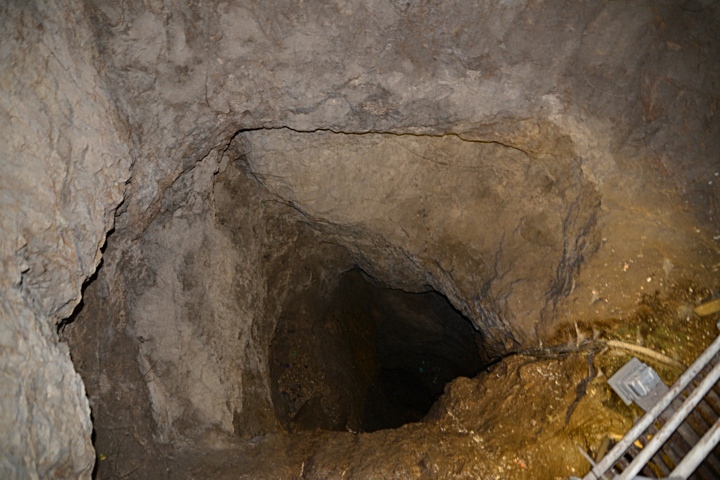
Further excavations by Professor Ronnie Reich and Eli Shukron dated the use of the shaft at the times of the Israelite kings (8th Century B.C.). According to their hypothesis, the existence of the natural shaft was found during that time when the floor of the tunnel was lowered for unknown reason. Therefore, the Warren shaft was not in use during the Canaanite period, a 1,000 years earlier. They also suggested that the shaft predates the Hezekiah tunnel of 701 B.C., which was hewn on the eve of the Assyrian assault. The archaeologists attributed the function of the shaft to the construction of the Shiloah tunnel, used to ventilate the air flow for the workers.
The next photo shows a natural opening – remains of a cave – above the Warren shaft. During the early times, before the water system was created, two cave openings on the surface of the foothill led down into the cave. The caves were in use during the Early Bronze age, 5,000 years ago, as living quarters. A thousand years later, during the Late Bronze age, a wall was erected in order to seal these openings, thus keeping it safe from the enemy.
The ladder at the edge of the cave continues up to the other cave.
On the other side of the wall is the second (southern) cave. Eli Shukron points to the ceiling of the natural cave, which was in use during the Early Bronze age for residence.
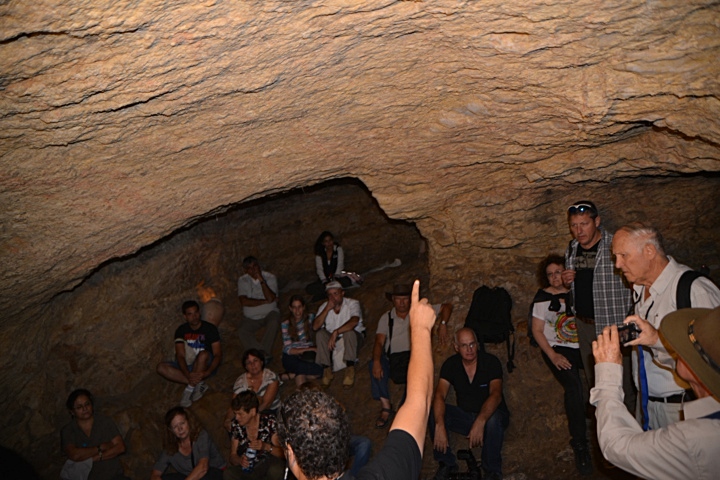
Years later, the Canaanites cut into the wall of the cave, seen on the back side of the cave, in order to continue the secret tunnel. However, they stopped digging that tunnel since its ceiling cracked. Instead, the Canaanites created a passage corridor above the cave in order to reach to the pool.
![]() Eli Shukron told about his discovery of the opening of the wall, from this southern cave to the spring house fortifications, during his excavations in 1997. You can listen to his story in Hebrew, recorded live and uncut, for 8:07 minutes, by clicking here.
Eli Shukron told about his discovery of the opening of the wall, from this southern cave to the spring house fortifications, during his excavations in 1997. You can listen to his story in Hebrew, recorded live and uncut, for 8:07 minutes, by clicking here.
(f) Spring house fortifications
The Gihon spring was the main source of water during the Bronze and Iron Age periods. As the spring was located at the bottom of the valley of Kidron, this posed an engineering challenge to the planners of the city: how to include it inside the fortified city, which was located 35 meters away from the spring at a height difference of 26 meters. The solution was to build a fortified structure high above the spring, and connect this tower to the fortified city. The elaborate fortified water complex was designed to allow the defenders a hidden access to the spring, while blocking the entry of the enemy.
The photo shows the fortified corridor from the southern cave on the edge of the secret tunnel to the fortified structure. Excavations here are still under way. Notice the huge boulders, rising 8m above the bedrock to a length of 24m, and weighing several tons. The massive Canaanite walls of the spring tower consisted of two parallel walls, with an impressive width of seven meters on the eastern wall that faces the valley. The size of the tower was 13.7m x 16.8m.
These type of walls made the Canaanite city (named Salem/Shalem) very well protected. Years later, during the 13th C conquest of Canaan, the Israelites could not conquer the city due to these walls. As per the Bible (1 Judges 21): “And the children of Benjamin did not drive out the Jebusites that inhabited Jerusalem”. King David finally captured the city at about 1,000 BC (2 Samuel 5): “Nevertheless David took the strong hold of Zion: the same is the city of David”.
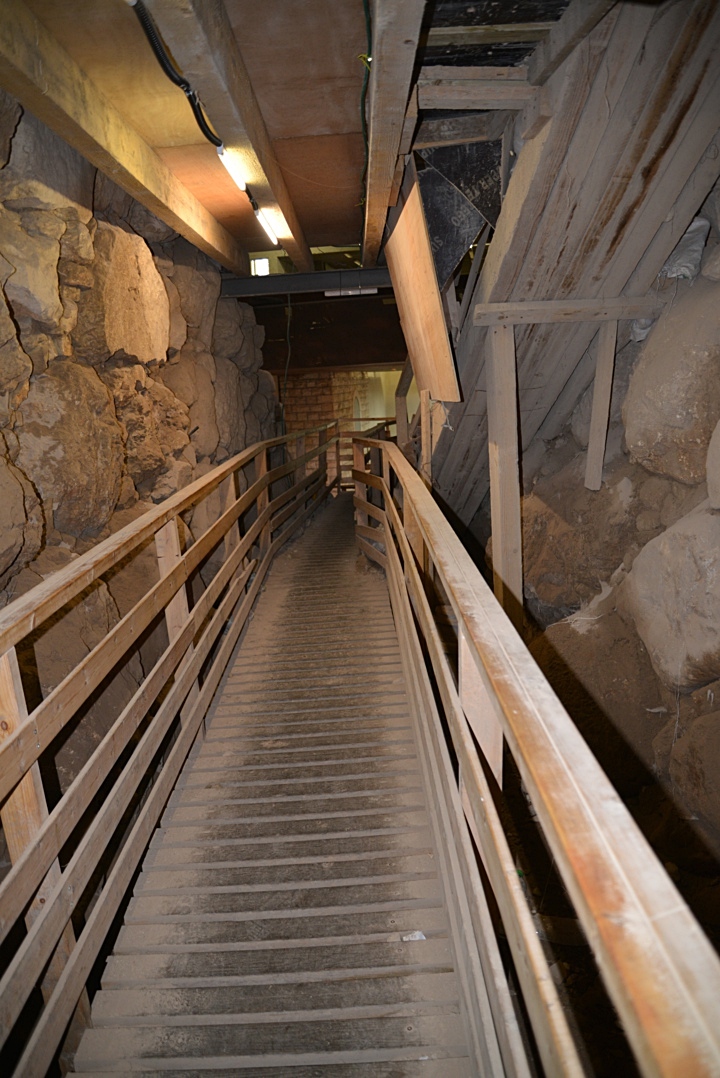
During the excavations, the spring tower was reinforced and reconstructed in order to allow the visitors to descend down to the Gihon spring. A modern building is adjacent to the tower, and the reconstructions had to overcome these constraints.
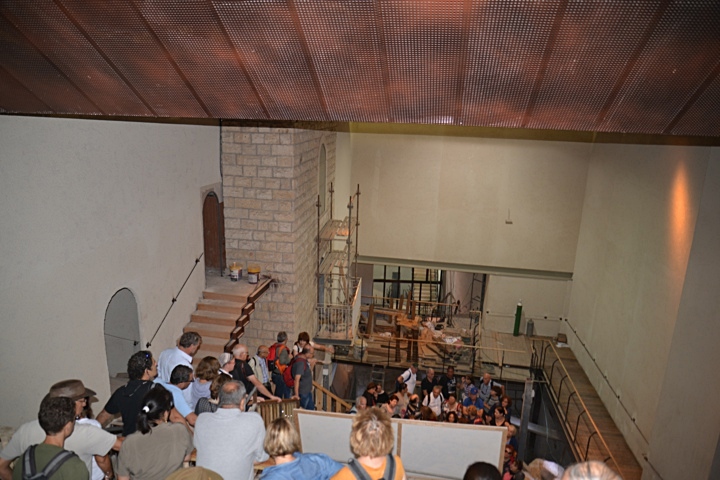
The spring tower, pool and access tunnels were built in the Middle Bronze period, at about 1800 B.C. An illustration of the tower and fortifications, as may have been standing at those times, are shown here from the east side. The pool was located on the left (south) side, while the tower on the right (north) was built over the spring.

-
Canaanite pool:
A view of the Canaanite pool is visible from the bottom of the staircase. On the side are sections of the walls of the tower that surrounded the spring house.
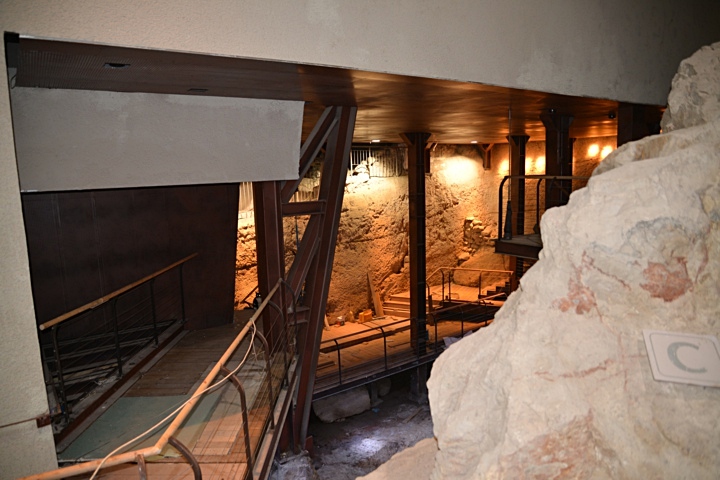
The Canaanite pool is located at the bottom of the spring house, at the south side of the complex. It is marked as a red square.
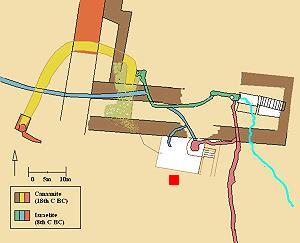
The pool was cut into the bedrock, and fed from the Gihon spring waters. The size of the pool is 10 by 14m, with a height of 14m. A deeper cavity (“the round room”) is located on the northeast corner, where it received the waters from a tunnel (“III”) originating from the Gihon spring.
The water was fetched by buckets from above the pool, on its north side, which was reached from the fortified corridor and later from the secret tunnel.
This pool may have been the site of the coronation of King Solomon (1 Kings 1 38-39): “So Zadok the priest, and Nathan the prophet, and Benaiah the son of Jehoiada, and the Cherethites, and the Pelethites, went down, and caused Solomon to ride upon king David’s mule, and brought him to Gihon. And Zadok the priest took an horn of oil out of the tabernacle, and anointed Solomon. And they blew the trumpet; and all the people said, God save king Solomon”.
The archaeologists had to clear thousands of years of debris from the pool, and discovered remains of 200 bullae, seals, Egyptian scarabs, and more than ten thousand (!) fish bones. The existence of the fish bones could indicate that the fish were imported to serve in the palace of the Judean Kings.
![]() Eli Shukron told about the excavations of the spring house, and these amazing findings. You can listen to his story in Hebrew, recorded live and uncut, for 11:48 minutes, by clicking here.
Eli Shukron told about the excavations of the spring house, and these amazing findings. You can listen to his story in Hebrew, recorded live and uncut, for 11:48 minutes, by clicking here.
A sample of the seals (on the left) and Egyptian scarabs (right) are shown by Eli, who describes their significance – remains from the times of the Judean Kings, who had trade and political ties with the region.
The access to the pool is from the Canaanite tunnel (Channel “II”), that connected the Gihon spring to the Kidron valley, 190m to the south. Along the tunnel, on the right side of the wall, is an opening to the Canaanite pool (Tunnel “III”), 5m to the west.
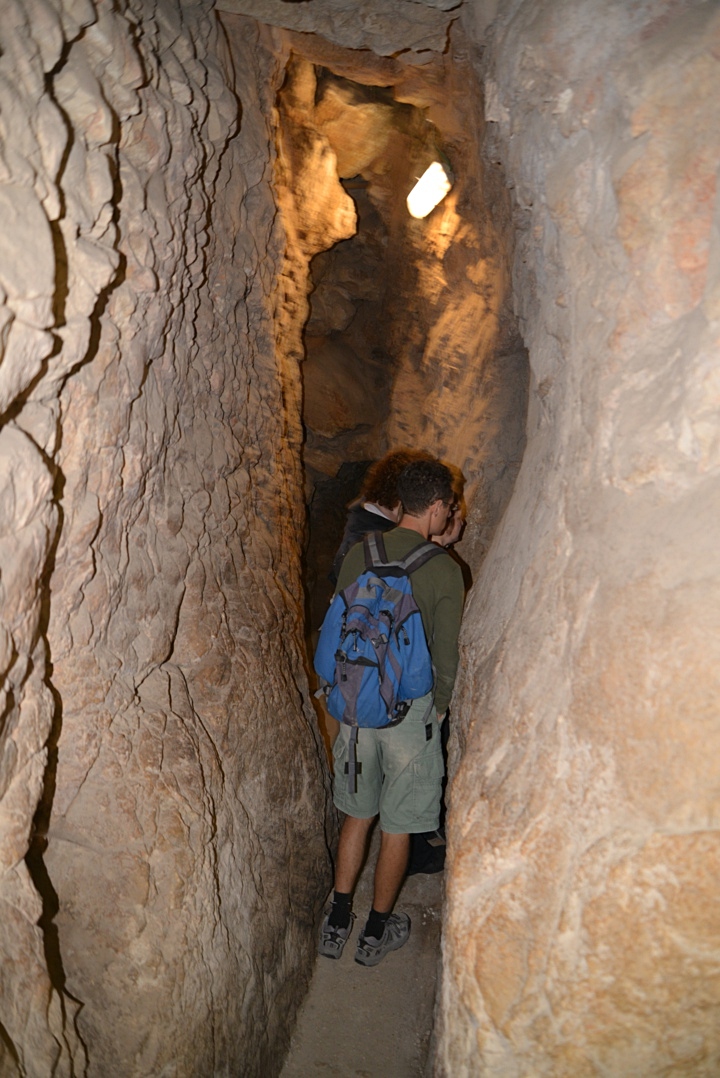
A small and narrow entrance leads to into the pool. The tunnel is 90 cm above the bottom of the pool, so it was constantly filling up the waters in the bottom of the pool. The Canaanites used buckets to fetch the water from the bottom of the pool.

The pool was in use until the 8th century B.C. The access through the fortified corridor was replaced at that time by an access through the secret tunnel complex passing near the Warren’s shaft. The Israelites cut a new 24m tunnel (“VI”) from a cave on the bottom of the Warren’s shaft to the spring, and another 10m tunnel (“IV”) from the Canaanite pool to the first tunnel. A longer 512.5m tunnel (“VIII”, also known as “Hezekiah’s tunnel”) was later cut into the rock, connecting the bottom of the Warren’s shaft to the Shiloah pool.
(g) Gihon Spring
Above the entrance to the spring is a vault, built during the second temple period. The structure was constructed in order to keep the water clean for the purpose using the spring water for ritual washing and practices of the temple. The temple water could not be fetched from the Shiloah pool or from the tunnel, as it was regarded less pure for the temple ritual purposes.
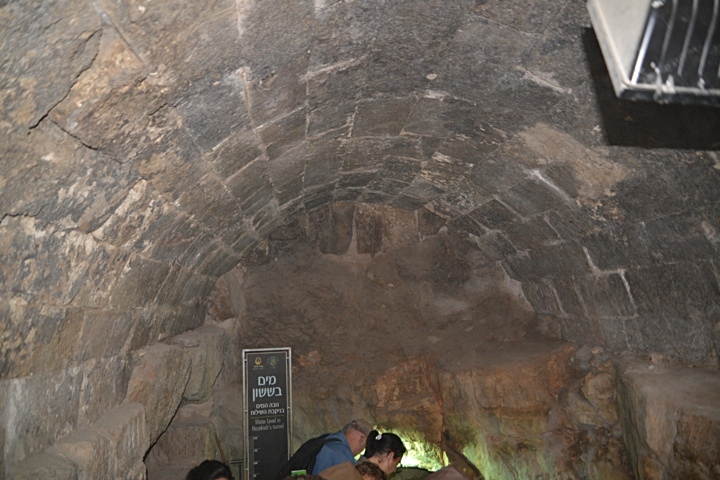
The vault over the spring was destroyed after the fall of Jerusalem. It returned to operation during the Mameluke period, after an earthquake caused an opening and revealed the source of the waters. This allowed the villagers to descend into the spring in order to fetch water.
An old photo (c. 1900-1920) of the entrance to the Gihon spring is seen below. The name of this entrance to the spring is called the “Virgin’s fountain” (Christian, “Ain Sitti Maryam” in Arabic) and also “The mother of steps” (Arabic, Um ed-Derej). This gave the name of the Kidron valley: Wadi Sitti Maryam – the valley of the Lady Mary.
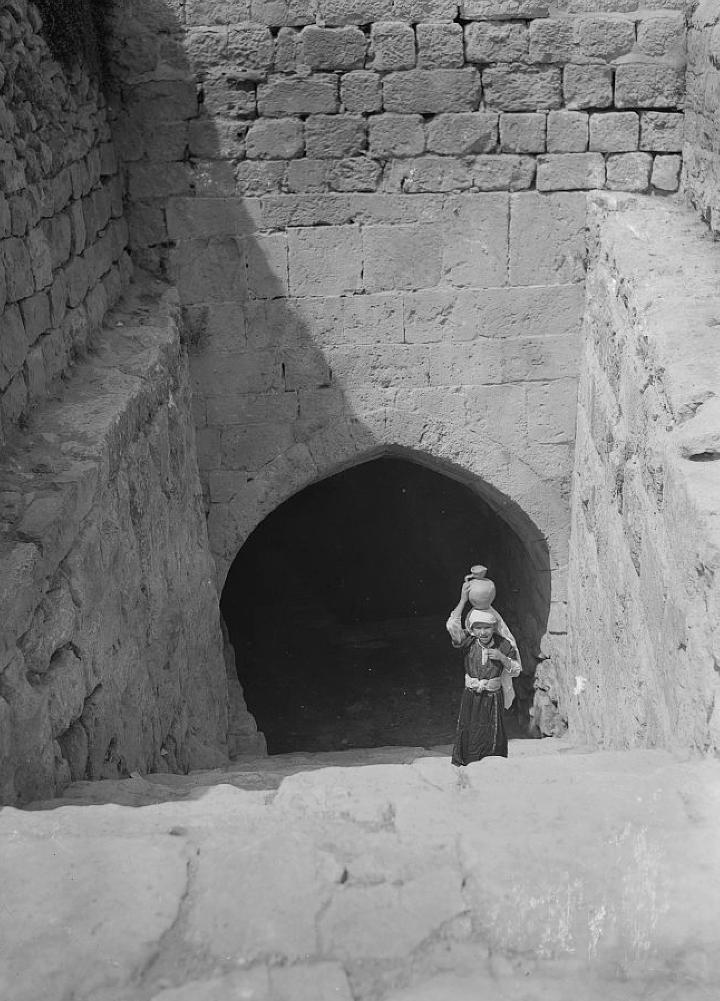
Library of congress – Valleys of Jehoshaphat and Hinnom. Virgin’s Fountain – American Colony Date: 1900-1920
![]() Eli Shukron told about this place and his excavations in 1997. You can listen to his story in Hebrew, recorded live and uncut, for 4:25 minutes, by clicking here.
Eli Shukron told about this place and his excavations in 1997. You can listen to his story in Hebrew, recorded live and uncut, for 4:25 minutes, by clicking here.

The location of the spring is indicated on the illustration as a red square.
A number of tunnels originate from the source – the south going Canaanite tunnels (III and II), and the west going Israelite tunnels (IV, VI and VIII).
Steps lead down to the spring, as seen in the photo below. On the wall is a sign – going straight down to the spring and to the Hezekiah’s tunnel, or going left through a new door to the Canaanite tunnel.
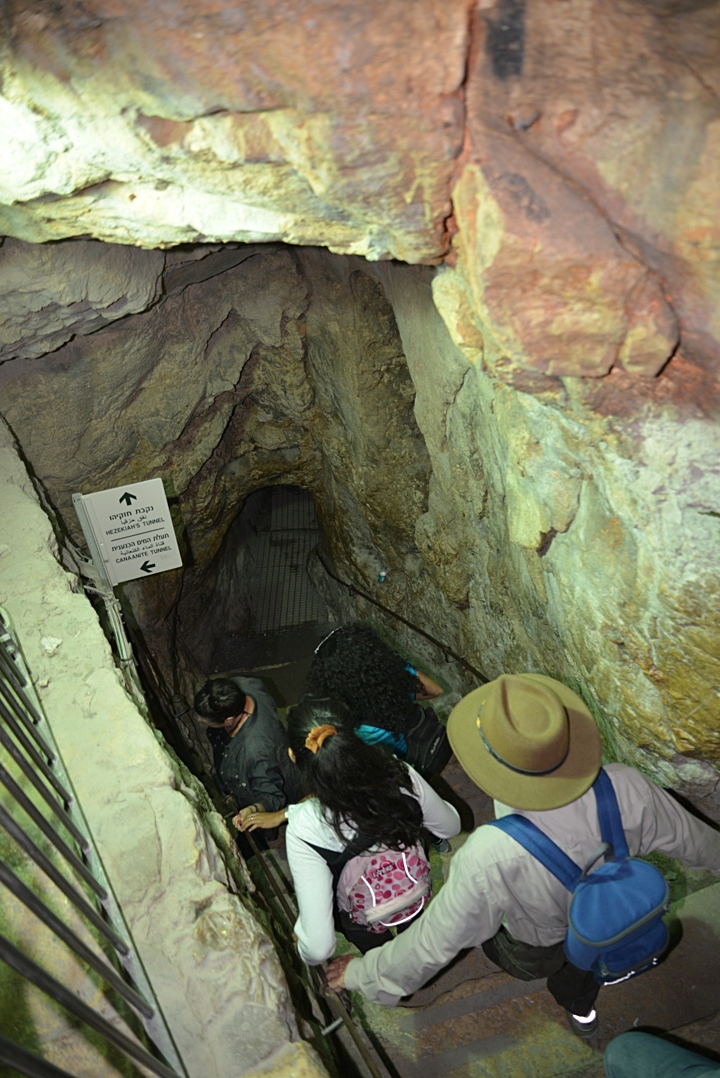
Several more steps lead down to the Gihon spring, and the beginning of the Hezekiah tunnel (tunnel “VI”).
The Gihon spring was the site of Solomon’s anointment, and according to these verses it is located under the palace (1 Kings 1:33-34, 39): “The king also said unto them, Take with you the servants of your lord, and cause Solomon my son to ride upon mine own mule, and bring him down to Gihon … anoint him there king over Israel: and blow ye with the trumpet, and say, God save king Solomon… “.
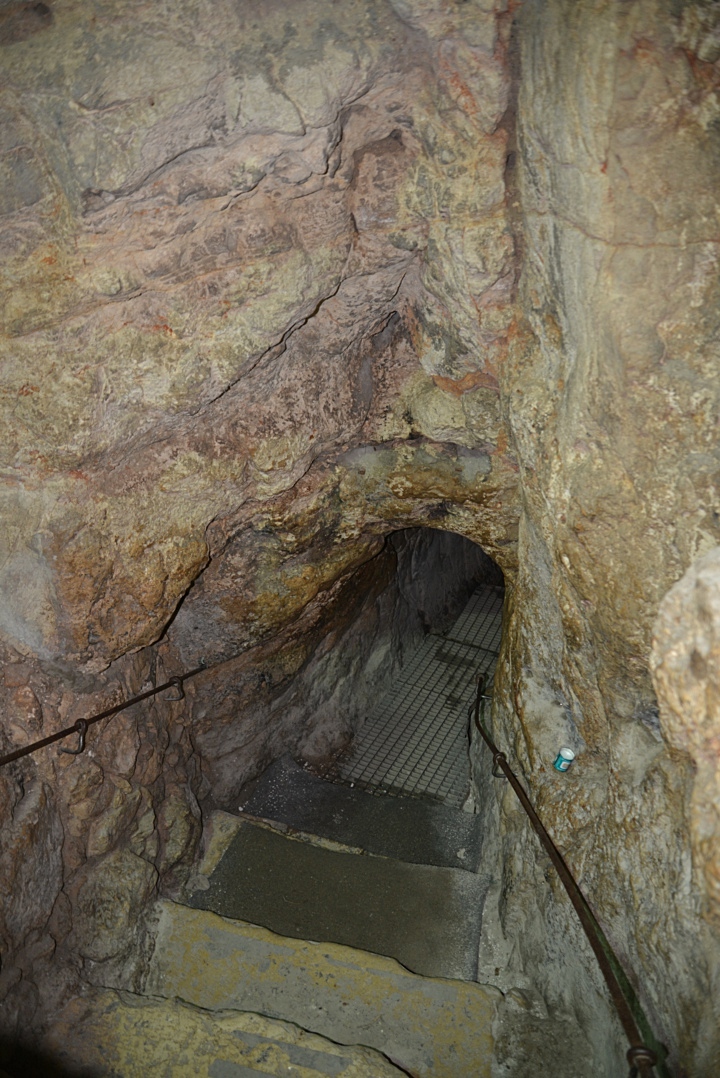
The spring is located at a depth of 10m under the surface, at a height of 634.65m above sea level. It supplies water at an average daily rate of 1,500m3 , with irregular flow during the day. This irregularity gave its name – Gihon – meaning “gusher”, as the water “emerges” in bursts.
In the book “Jerusalem in Bible times” (“The springs and pools of ancient Jerusalem”, 1907, p. 170) Lewis Paton explains: ” Owing to some siphon-like formation of the caverns through which the water comes, this spring is intermittent, and this characteristic causes it to be regarded with superstitious reverence”.
The water of the spring flow below the metal grate. Behind it is the entrance to “Hezekiah’s” tunnel (“tunnel VI”).
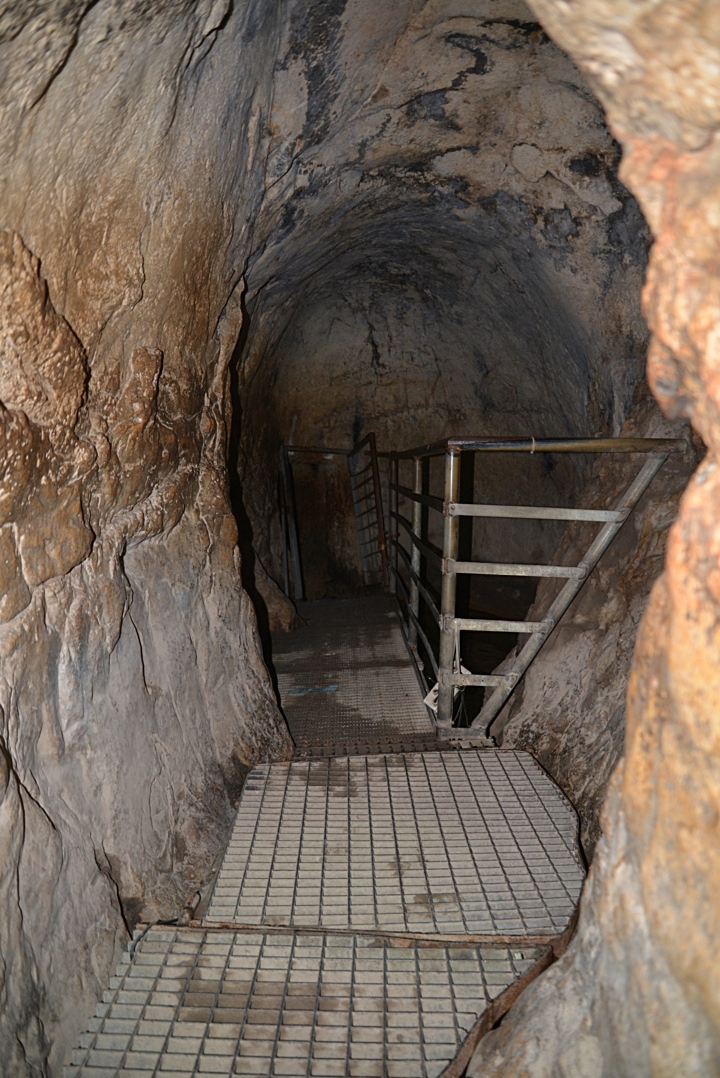
(h) Hezekiah Tunnel
Beyond the spring is an entrance to the first tunnel (“VI”), which connects the spring to the bottom of the Warren’s shaft.
It then continues as a 512.5m long tunnel, known as Hezekiah’s tunnel (“Tunnel VIII”). This tunnel is marked as a red square. The tunnel starts west, but then turns south.
The tunnel was also cut into the rock, leading the water along the eastern hill to the Shiloah pool, which was located inside the fortified City of David. This tunnel is still a functioning canal, feeding the Shiloah/Siloam pool (or in Arabic: Ain Silwan).
A section of the tunnel is seen here in an old photo. The tunnel is rectangular, with a a width of 60cm, a height of 1.85m, and 2/3 of its height is plastered.
The shallow waters flow gently along the tunnel. You can walk along the winding wet tunnels from the Gihon spring to the Shiloah Byzantine period pool. The height difference between the source and the destination is 30 cm (0.06%).
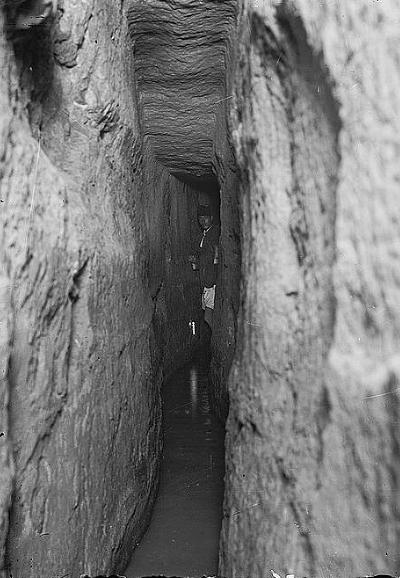
Siloam tunnel – Library of Congress; American col. photographers [1900-1920]
A 2,800 years old inscription was found on a wall of the tunnel, 6m from the end of the tunnel at the Shiloah pool. This inscription, 6 lines of ancient Hebrew script carved on the limestone rock, was one of the important findings of Biblical archaeology in the 19th Century. It was found in 1880 and brought to Istanbul, where it is on display today. The Shiloah (Siloam) inscription tells the story of the tunnel, and how the two teams of diggers met after cutting the tunnel on both ends:
“… (When) (the tunnel) was driven through. And this was the way in which it was cut through: While (…) (were) still (…) axe (s), each man toward his fellow, and while there were still three cubits to be cut through, (there was heard) the voice of a man calling to his fellow, for there was an overlap in the rock on the right (and on the left). And when the tunnel was driven through, the quarrymen hewed (the rock), each man toward his fellow, axe against axe; and the water flowed from the spring toward the reservoir for [twel]ve hundred cubits, and the height of the rock above the head of the quarrymen was 100 cubits”. (W.F. Albright, ANET 321)
Siloam inscription ;limestone [Istanbul Archaeological Museum]
The Bible recorded the historical events leading to the construction of the tunnel, which gave it the common name “Hezekiah tunnel”. Hezekiah (King 716-687 B.C.) prepared Judea on the eve of the Assyrian intrusion, and constructed the tunnel, and blocked the old Canaanite watercourse, in order to prevent the waters of the Gihon to be used by the enemy. (2 Chronicles 32 2-4):
“And when Hezekiah saw that Sennacherib was come, and that he was purposed to fight against Jerusalem, He took counsel with his princes and his mighty men to stop the waters of the fountains which were without the city: and they did help him. So there was gathered much people together, who stopped all the fountains, and the brook that ran through the midst of the land, saying, Why should the kings of Assyria come, and find much water?”.
The tunnel brought the spring waters into the walls of the city of David, rather than flowing out to the Kidron (2 Chronicles 32 30): “This same Hezekiah also stopped the upper watercourse of Gihon, and brought it straight down to the west side of the city of David”.
The tunnel project is also summarized in Hezekiah’s Biblical “obituary” (2 Kings 20 20): “And the rest of the acts of Hezekiah, and all his might, and how he made a pool, and a conduit, and brought water into the city, are they not written in the book of the chronicles of the kings of Judah?”.
According to recent findings by the archaeologists, tunnel VIII was hewn several years before the times of Hezekiah, or during his reign. Due to the complexity of the project, it was not finished in time for the Assyrian army intrusion of 701, led by Sennacherib. Hezekiah then hurried to dig the other channel (southern section of “channel II”), and only after the Assyrians retreated, continued to complete this tunnel.
(i) Canaanite tunnel:
In 1997 the excavators cut an opening on the left wall at the bottom of the steps leading to the spring, in order to allow easier passage to the Canaanite pool and tunnel.
Inside the entrance to the Canaanite tunnel are two boulders, which prevented easy access to the spring. Past the boulders is an entrance to the Canaanite pool, on the right wall. The Canaanite tunnel fed water to fill up the pool.

- Northern section
The Canaanite tunnel (northern section of “tunnel II”, marked as a red square) starts from this place.
It flows out of the hill after a distance of 190m, where it then flowed to the Kidron valley in order to water the fields and fill a reservoir. The tunnel was cut into the rock 800 years before David, during the Canaanite period.
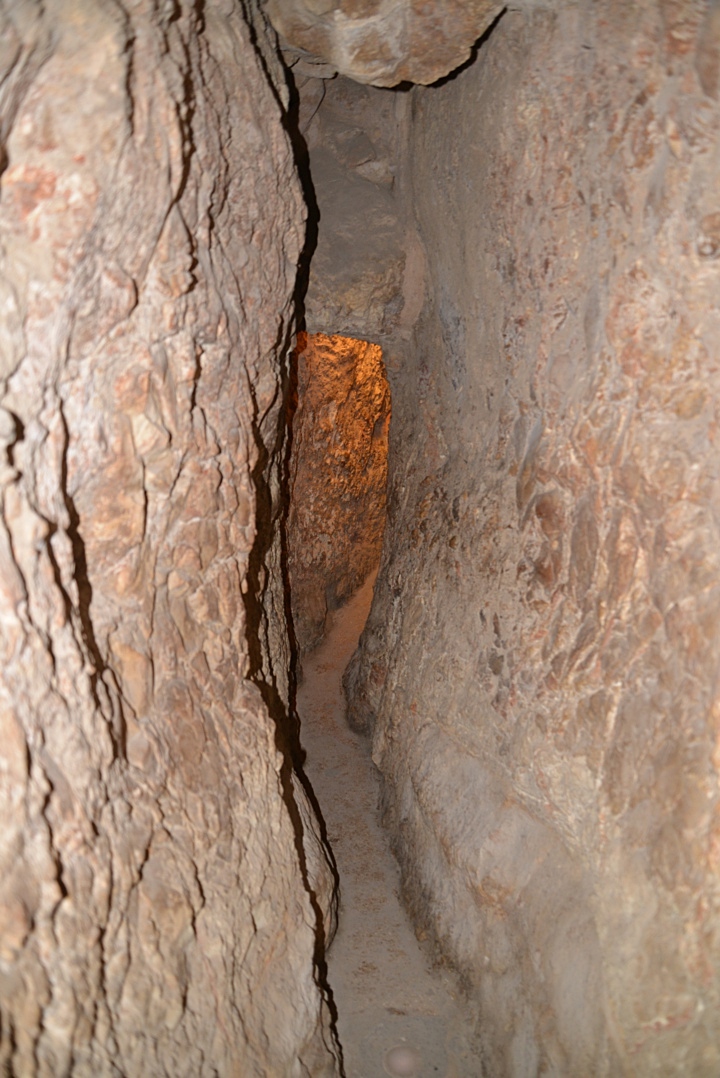
The tunnel was discovered by the Archaeologist Masterman in 1901. It may have been the “gutter” in which David’s soldiers entered into the city of the Jebusites (2 Samuel 5 6-9):
“And the king and his men went to Jerusalem unto the Jebusites, the inhabitants of the land: which spake unto David, saying, Except thou take away the blind and the lame, thou shalt not come in hither: thinking, David cannot come in hither. Nevertheless David took the strong hold of Zion: the same is the city of David. And David said on that day, Whosoever getteth up to the gutter, and smiteth the Jebusites. , and the lame and the blind that are hated of David’s soul, he shall be chief and captain. Wherefore they said, The blind and the lame shall not come into the house. So David dwelt in the fort, and called it the city of David. And David built round about from Millo and inward.”.
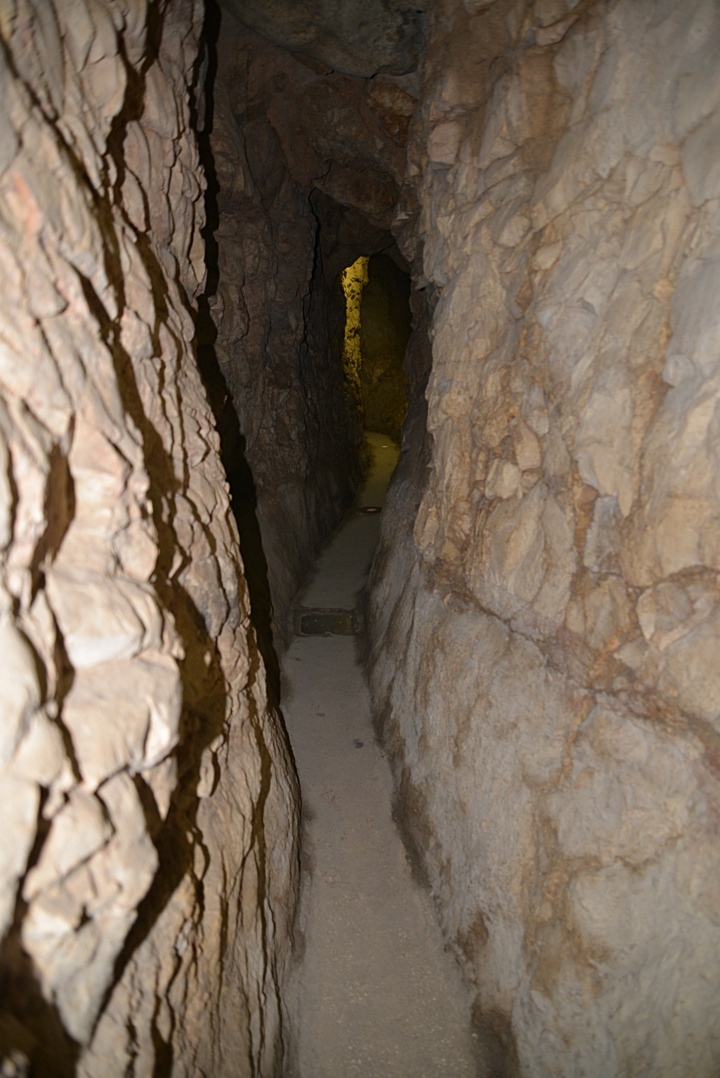
The exit of the Canaanite tunnel II ends in the Kidron valley, within the modern Arab village of Silwan. In ancient times, the waters filled a pool, which then served the Canaanites, their herds and the farming along the valley.

- Southern extension
The outlet of the 18th Century B.C. Canaanite watercourse was blocked in the 8th Century B.C., probably by King Hezekiah, in order to prevent it from flowing out to the Kidron. A southern extension tunnel (“Shiloah channel II”), was then constructed, diverting the waters to the Shiloah pool for additional 210m southwards.
The construction of the underground channel was done by cutting vertical shafts from the hillside, then cutting sideways to connect the segments of the tunnel. The water channel is 1.5m high, and its walls are without plastering. The channel has an upside down trapezoid form – it is narrow (30cm) at its bottom side, and wider (50cm) on its upper side.
The construction of the tunnel is described in the Bible (2 Chronicles 32 30): “This same Hezekiah also stopped the upper watercourse of Gihon, and brought it straight down to the west side of the city of David”.
After the completion of the second tunnel (“Tunnel VIII”) , which is lower by 1.5m, the Canaanite tunnel and its extension dried out forever.
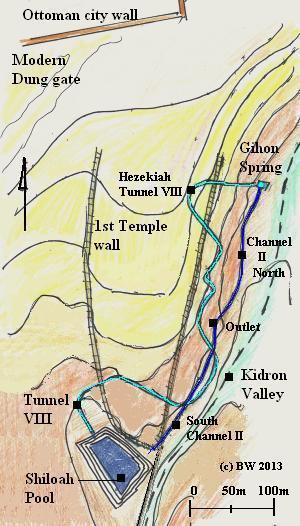
Area of the Gihon spring and the Shiloah pool
(j) Excavation findings:
Many rich findings were found in the excavations of the Gihon spring area.
- Bowl inscription
One of the finds, a 2,700 years old pottery shred of a bowl, bears a partial inscription: “ryhu bn bnh”. The bowl was produced in the 8th-7th century B.C., probably between the reigns of Hezekiah and Zedekiah. Although this ancient Hebrew inscription is incomplete, it may have read “Zechariah the son of Benaiah” -the father of prophet Jahaziel (2 Chronicles 20:14): “Then upon Jahaziel the son of Zechariah, the son of Benaiah, the son of Jeiel, the son of Mattaniah, a Levite of the sons of Asaph, came the Spirit of the LORD in the midst of the congregation;”.
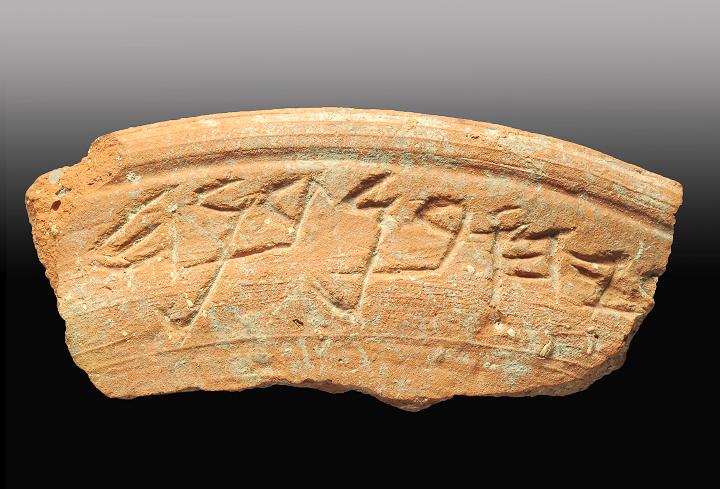
Photo courtesy of IAA
- First Temple Period ceramics
The next photos shows various finds from the fill layer of the end of first Temple period. Theses ceramics include oil lamps, stamped handles and female figurines.

Photo courtesy of IAA
- LMLK stamp
The stamped handle of the photo above is a royal seal which was imprinted on jars with the Hebrew letters LMLK (“L’melekh”), meaning “belonging to the king”. These type of stamped handles were found in 16 sites in Israel. According to G.M. Grena of LMLK.com: “As for dates, the majority of scholars believe these seal impressions date to the 8th-7th centuries B.C.. These dates center around the reign of King Hezekiah because the handles appear in strata formed by a destruction layer caused by the Assyrian king, Sennacherib. Some scholars believe the handles were stamped as early as the reign of Uzziah, & as late as Manasseh, though some believe they were strictly limited to Hezekiah’s reign”.
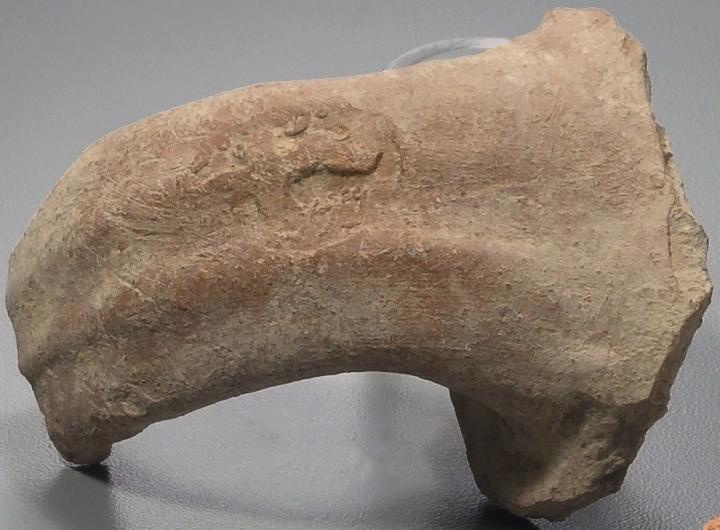
Photo courtesy of IAA
- Bulla of Bethlehem
Another interesting bulla (clay seal) was found while sifting through the soil in the Gihon spring. This was reported by the IAA (May 2012): “The first ancient artifact constituting tangible evidence of the existence of the city of Bethlehem, which is mentioned in the Bible, was recently discovered in Jerusalem. A bulla measuring c. 1.5 cm was found during the sifting of soil removed from archaeological excavations the Israel Antiquities Authority is carrying out in the City of David. The sifting is underwritten by the ‘Ir David Foundation’ in a project being conducted in the Emek Tzurim National Park.
According to Eli Shukron, director of the excavation on behalf of the Israel Antiquities Authority, it seems that in the seventh year of the reign of a king (it is unclear if the king referred to here is Hezekiah, Manasseh or Josiah), a shipment was dispatched from Bethlehem to the king in Jerusalem. The bulla we found belongs to the group of fiscal bullae administrative bullae used to seal tax shipments remitted to the taxation system of the Kingdom of Judah in the late eighth and seventh centuries BCE. The tax could have been paid in the form of silver or agricultural produce such as wine or wheat. Shukron emphasizes, this is the first time the name Bethlehem appears outside the Bible, in an inscription from the First Temple period, which proves that Bethlehem was indeed a city in the Kingdom of Judah, and possibly also in earlier periods.
In the Bible Bethlehem is first mentioned in the verse in Ephrath, which is Bethlehem, and it was on the way there that Rachel died and it is where she was buried (Genesis 35:19; 48:7). The descendants of Judah settled there, among them the family of Boaz (Book of Ruth)”.
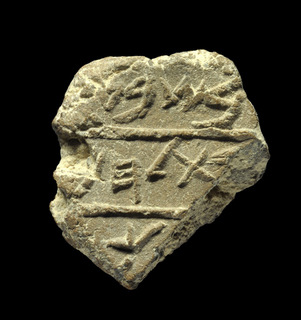
Bethlehem Bulla – courtesy of IAA
Three lines of ancient Hebrew script appear on the bulla:
בשבעת Bishv’at
בת לחם Bat Lechem
[למל]ך [Lemel]ekh
Etymology:
- Gihon – Name of the spring, perhaps based on Hebrew name meaning “emerging” in bursts – or the : “gusher” spring.
- Ein Um ed-Daraj – Arabic name of the spring outlet in the Kidron (“Spring of the mother of steps”)
- Spring of the Lady Mary, Virgin’s fountain – Christian name of the spring (in Arabic: Ain Sitti Maryam).
- Shiloah – Hebrew name of the pool, where the waters of Gihon were diverted
- Siloam – New Testament name of Shiloah (John 9, 7): “And said unto him, Go, wash in the pool of Siloam, (which is by interpretation, Sent.) He went his way therefore, and washed, and came seeing”.
- Silwan – Arabic name of the village of near the Shiloah name, which preserved its name
Links:
* External links:
- City of David – Ancient Jerusalem archaeological park
- Water works of Jerusalem during the first temple period (Hebrew, 1991)
- Library of Congress – historic pictures of the Holy Land
- 2,700 years old inscription (IAA, Aug 2013)
- South section of Channel II, Shiloach, both of King Hezekiah. (Asher Grosberg; pdf, 56 pages, Hebrew; 2012) – recommended!
* Biblewalks links:
- City of David archaeological park, entrance to the Gihon spring
- Shiloah Pool – ancient pool of Shiloah/Siloam
- Central drainage canal – accessed from the Shiloah pool
- Givati Car Park – excavation area
- Biblical Water works – other sites with impressive water systems
BibleWalks.com – navigate with the Bible
Tililya <<<—previous Jerusalem site–<<< All Sites >>>—>>> City of David
![]()
This page was last updated on Feb 25, 2023 (new overview)
Sponsored links:
